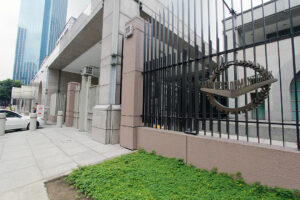THE ASIAN Development Bank (ADB) has retained its growth forecast for the Philippines for this year, citing a strong rebound in domestic demand as the economy continues to reopen despite growing inflation risks.
In its Asian Development Outlook (ADO) 2022 Update report released on Wednesday, the multilateral lender said it expects the country’s gross domestic product (GDP) to grow by 6.5% this year, steady from its July forecast.
However, this is at the lower end of the government’s 6.5-7.5% target for this year.
Philippine GDP expanded by 7.4% in the second quarter, slowing from the 8.2% seen in the previous quarter. This brought the first semester average to 7.8%.
“The normalization of socioeconomic activity will usher the Philippine economy to a steady, pre-pandemic pace of expansion,” ADB Philippines Country Director Kelly Bird was quoted as saying in a statement.
“The recovery in tourism and private investments, coupled with sustained public spending on large infrastructure projects and remittances from overseas Filipinos, will bolster the country’s economic recovery this year.”
At 6.5%, the Philippines is expected to be the fastest-growing economy in Southeast Asia this year, along with Vietnam. This forecast is also above the ADB’s 5.1% growth outlook for the entire region, which was raised from 5% in July.
However, the ADB now expects Philippine inflation to average at 5.3% this year, up from the July forecast of 4.9%, due to “sharp upward shocks to global energy and commodity prices” and “the negative impact of natural disasters on domestic agricultural supply [that] will likely lead to higher food prices until the end of the year.”
“The import-dependent economies have been hit hard simply because, across the region, import bills have ballooned, more so for the smaller economies,” ADB Senior Regional Cooperation Officer for Southeast Asia Dulce Zara said in a webinar on Wednesday.
“Price increases coupled with weaker local currencies, it has inflated their import bills,” she added.
The central bank sees headline inflation averaging 5.4% this year, well above its 2-4% target.
Headline inflation eased to 6.3% in August from a near four-year high of 6.4% in July, bringing the eight-month average to 4.9%.
Ms. Zara also flagged risks from China’s slowdown, especially since it is among the Philippines’ top trade partners.
Meanwhile, the ADB also kept its Philippine GDP growth forecast for 2023 at 6.3% “as monetary policy tightening and accelerating inflation both crimp domestic demand.” This is the second-fastest forecasted expansion in Southeast Asia for next year, following Vietnam’s 6.7%, and is below the official target of 6.5-8%.
It likewise maintained its inflation forecast of 4.3% for next year “since the return to steady economic growth will keep inflation relatively stable, and with energy prices likely to decelerate.”
Abdul Abiad, director of ADB’s Macroeconomic Research Division, said central bank policy rates are expected to continue rising to counter inflation and to support weakening currencies due to the dollar’s strength amid the US Federal Reserve’s tightening cycle.
“The peso has depreciated by about 13% so far… [but] the Philippines is not at the extreme end; it’s very much close to the average for the region,” Mr. Abiad said. “Much of the depreciation in the Philippine peso reflects, not so much weakness in the peso, but strength in the dollar, driven by the Fed tightening.”
The Bangko Sentral ng Pilipinas (BSP) has hiked borrowing costs by a cumulative 175 basis points since May, and is expected to continue hiking rates to rein in rising inflation.
On Wednesday, the peso closed at a new low of P58 per dollar, down by 52 centavos from the previous day, as markets awaited the Fed’s decision overnight.
Year to date, it has lost 13.73% in value against the greenback, making it one of the region’s worst performers.
Aside from inflation, which it mostly attributed to the Russia-Ukraine conflict, the ADB said other risks to growth, include a sharper slowdown in major advanced economies and heightened geopolitical tensions.
DEVELOPING ASIAMeanwhile, the ADB cut its growth forecast for developing Asia this year and 2023, amid tighter global monetary policy, the Russia-Ukraine conflict, and the lockdowns in China due to the coronavirus disease 2019 (COVID-19).
The ADB downgraded its 2022 growth outlook for developing Asia to 4.3%, slower than the 4.6% projection in July.
In 2023, developing Asia is projected to expand by 4.9%, down from the previous 5.2% forecast.
“Domestic consumer spending and investment are driving growth as economies in the region continue to relax pandemic restrictions, thanks in part to vaccination drives and declining COVID-19 mortality. However, the continuing invasion of Ukraine has heightened global uncertainty, worsened supply disruptions, and unsettled energy and food markets,” the ADB said.
“More aggressive monetary tightening by the US Federal Reserve and the European Central Bank is denting global demand and rattling financial markets. Meanwhile, sporadic COVID-19 outbreaks and new lockdowns have slowed growth in [China], the region’s largest economy,” it added.
Excluding China, which is also challenged by a weak property sector, the rest of developing Asia is projected to grow by 5.3% in both 2022 and 2023.
“This will be the first time in more than three decades that China will be growing slower than the rest of developing Asia. In other words, it’ll be a drag on growth rather than an engine of growth for the region,” said Mr. Abiad in an episode of ADB Insight released on Wednesday.
ADB Chief Economist Albert Park said while the region has seen some recovery, risks still “loom large,” including slower global growth that could affect exports, as well as aggressive monetary tightening that could lead to financial instability. — Diego Gabriel C. Robles
